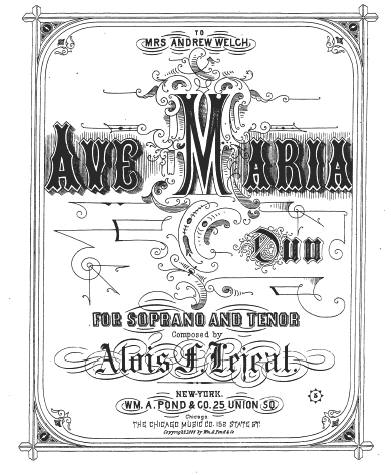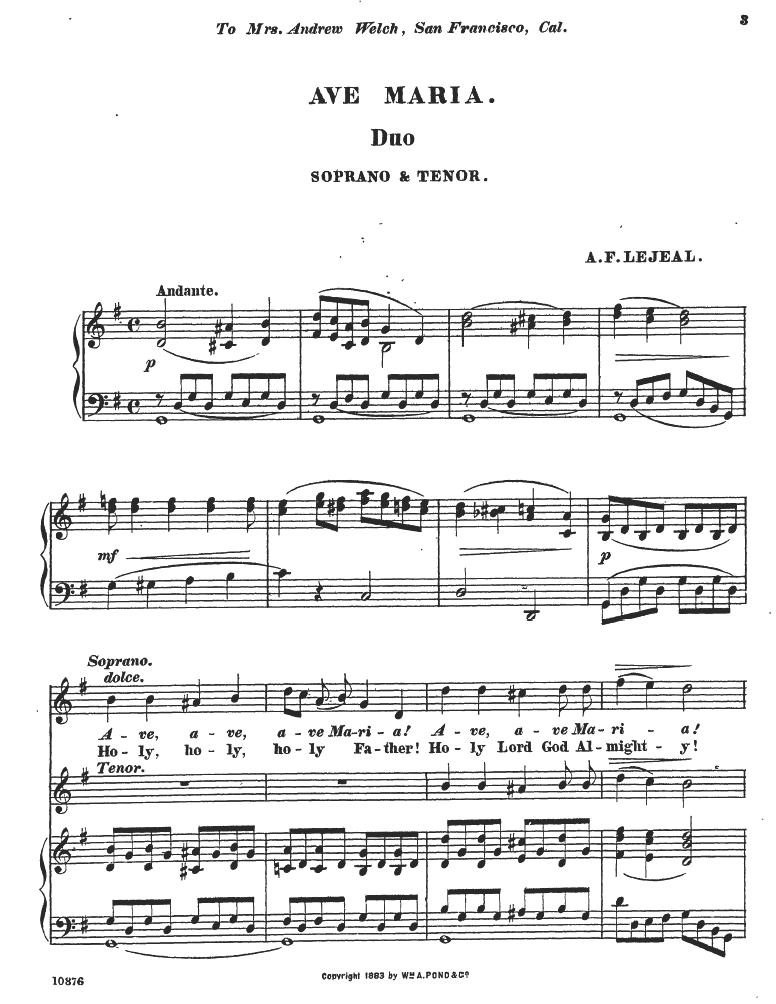Ave Maria for soprano and tenor
Composer: Alois Francis Lejeal (1840-1920), 1883

| Recording: not available |
|
| Lyrics: |
 Score:
Score: |
|
A ve, a ve, a ve Ma ri a!
A ve, a ve Ma ri a!
A ve, a ve, a ve Ma ri a,
gra tia ple na, gra tia ple na.
A ve Ma ri a, gra ti a ple na,
Do mi nus, Do mi nus te cum.
Be ne dic ta, be ne dic ta tu in mu li e ri bus,
et be ne dic ta, et be ne dic ta tu in mu li e ri bus,
tu in mu li e ri bus,
et be ne dic tus, et be ne dic tus,
et be ne dic tus, et be ne dic tus
fruc tus ven tris tu i Je .su.
Sanc ta Ma ri a, Ma ter De i,
o ra pro no bis pec ca to ri bus.
O. ra pro no bis, pro no bis,
nunc et in ho ra mor tis nos trae.
Sanc ta Ma ri a Ma ter De i,
o ra pro no bis, o ra, o ra pro no bis o ra pro no bis,
Ma ter De i Ma ter De i,
o ra pro no bis, o ra, o ra, o ra pro no bis,
o ra pro no bis pec ca to ri bus,
nunc et in ho ra mor tis nos trae
A men.
In ho ra mor tis nos trae. A men.
A men.
|

|
|

|
| Internet reference:
source |
ALOIS FRANCIS LEJEAL, one of
the best known and most accomplished musicians on the pacific coast, was
born in Alsace, France, in 1840 and was reared and educated in his native
country. His uncle, Ignatz Garner, who was prominent in the musical
profession, gave him his first instructions, which he continued under Ig.
Trueg, and studied counter point with M. E. Sachs. Upon completing his
musical course Mr. Lejeal came to New York, and later founded the New York
Conservatory of Music, in conjunction with the well-known violin virtuoso,
Edward Mollenhauer, and S. N. Griswold, in 1867. In the following year Mr.
Lejeal assumed the sole musical direction of the conservatory, then
numbering about 1,500 students. He taught the advanced classes on the
piano, and also took an active part as pianist in the concerts of the
conservatory, given under his directions. On account of ill health,
resulting from over-work, he came to the land of golden promise, and in
1875 became a resident of San Francisco, and since then, for the past
sixteen years, he has been successfully engaged in giving instructions in
piano and harmony. Professor Lejeal has done much in composition and as
musical author, and among his works the Modern School of Piano Technics is
deserving of special mention. It comprises over 150 quarto pages, and is
well calculated to prepare the hands of all requirements of modern
virtuosity. Chromatic progression through all the keys is a predominent
feature of the work, and all the triads and chords of the sevenths with
their resulting arpeggios are treated in an exhaustive manner. Among his
piano solos are Atalanta Fantaisie, Minuet de la Princesse, Twilight
Reverie, a suite in five numbers for piano and violin, etc. Among his
vocal compositions are four Masses, a Requiem, Vespers, Episcopal morning
and evening services, Te Deums, duets, etc.
Professor Lejeal has had a long and successful experience in teaching and
enjoys an enviable reputation in the profession in New York, Boston,
Philadelphia and other Eastern cities, and with the most eminent musicians
of the musical centers of Europe. He takes yearly vacation visits in New
York, Boston, Philadelphia and other Eastern cities. Professor Lejeal has
an elegant and attractive home on Clay street in this city.
Transcribed by 10-23-06 Marilyn R. Pankey.
Source: "The Bay of San Francisco," Vol. 2, Page 163, Lewis Publishing Co,
1892. |

Page last modified:
November 07, 2011
Return to my homepage:
www.avemariasongs.org

|
![]()